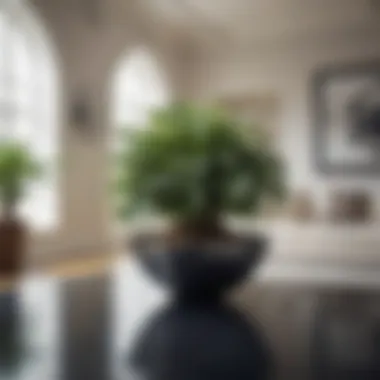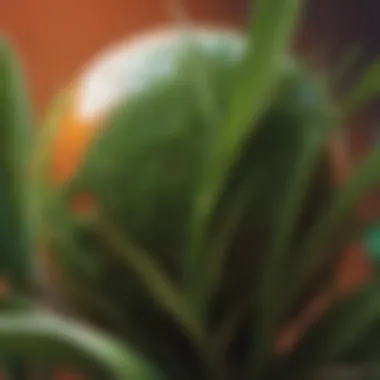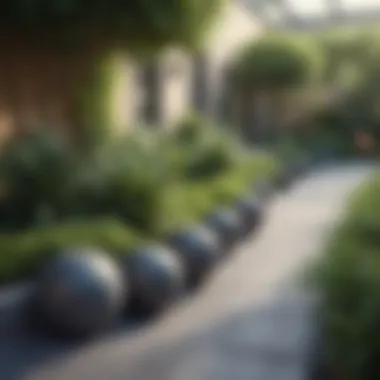The Art and Utility of Round Ball Artificial Plants


Intro
In a world where aesthetic sensibility often dictates the design of our living spaces, the rise of artificial plants, particularly those styled in round ball formats, is undeniably significant. These botanical creations blend the beauty of nature with the demands of modern life, offering both a splash of green and a low-maintenance alternative to their living counterparts. As designers and enthusiasts alike explore how such elements fit into the broader tapestry of home decor and fashion, it’s imperative to understand both the visual allure and the practical implications of these designs.
Round ball artificial plants serve not just as decorative items; they embody the marriage of form and function, catering to the needs of various environments—from chic urban apartments to bustling offices. In recognizing the versatility of these products, one starts to uncover how they can elevate spaces and influence fashion trends. Each sphere represents a new canvas for creative exploration, inviting a deep dive into the aesthetic possibilities that color, texture, and material can offer.
Moreover, as the conversation around sustainability gains momentum, these faux flora emerge as a viable option for conscientious consumers. They challenge traditional notions of decor by presenting an environmentally friendly alternative that doesn't sacrifice style for practicality. Thus, this article navigates the intricate landscape of round ball artificial plants, shedding light on their aesthetic roles, practical applications, and the current trends in fashion and design that they beautifully complement.
The Allure of Artificial Plants
The use of artificial plants has become a staple in both residential and commercial settings, providing the opportunity to incorporate greenery without the associated upkeep. In this discussion, we explore the numerous benefits and considerations surrounding artificial flora with a specific focus on round ball designs.
Defining Artificial Flora
Artificial plants are crafted to mimic the appearance of living plants while offering practical advantages. Made from materials like plastic or synthetic resins, these creations eliminate the need for sunlight and watering. However, they should not be mistaken for mere decorative items. The artistry involved in crafting these plants can be quite intricate, allowing them to mimic the texture, color, and shape of natural flora in a remarkably convincing manner.
An essential aspect to keep in mind is that the definition of artificial plants goes beyond basic imitations. Many modern designs often incorporate elements like UV protection, which helps prevent fading when used in sunlit spaces. There are also plant designs that are sold in more eco-friendly options, aligning with a growing interest in sustainability among consumers.
The Appeal of Round Designs
The aesthetic appeal of round ball designs lies in their simplicity and versatility. Unlike traditional plant shapes, which can sometimes feel overwhelming or overstylized, round designs exude a sense of balance and harmony. These orbs can fit comfortably in various settings, whether it be perched on a coffee table, in a corner nook, or as part of a larger arrangement.
- Space Efficiency: Their compact shape occupies less space, making them suitable for small apartments or crowded rooms.
- Visual Interest: Round forms often pull the eye in, leading to a captivating focal point in a design scheme.
- Flexibility: They can work well with differing decor styles, from contemporary to bohemian, thus appealing to a wide audience.
Consider how a single round ball plant can transform a space. Take, for instance, a plain wooden dining table. Placing a lush, green, round plant on it adds a refreshing touch, elevating the overall ambiance instantly. Furthermore, these designs often lend themselves well to creative arrangements, giving designers and stylists more freedom to play with placements and pairings.
"Artificial plants cater to our natural inclination toward greenery while eliminating the hassle of maintenance."
In summary, the allure of artificial plants, particularly in round ball designs, is not just about aesthetics. It highlights the intersection of functionality and design, creating a perfect blend that resonates with modern lifestyles.
Design Aspects of Artificial Plants
When it comes to the conversation about artificial plants, the design aspects can’t be sidestepped. These elements play a critical role in both their aesthetic appeal and practicality. Whether it’s the materials used, the colors and textures available, or the overall craftsmanship that brings these pieces to life, understanding these aspects helps in appreciating their growing popularity. Moreover, as more individuals seek out innovative designs to spruce up their spaces, knowing the ins and outs of these design elements can be the difference between a space that feels lifeless and one that radiates charm.
Material Choices
Plastic
Plastic has earned its stripes in the world of artificial plants. The versatility it offers is unmatched. For starters, one of the primary characteristics of plastic is its durability. Unlike natural materials that can wilt over time, plastic maintains its form and color, giving it an edge in longevity. This means less frequent replacements and more bang for your buck, which is a key consideration for many designers and retail establishments.
However, one unique feature of plastic is its lightweight nature. This makes it easier to manage and arrange within various settings without straining one’s back. Yet, it also comes with its own set of challenges. While it does resist fading, if not treated properly, it can become brittle over time, leading to potential damage. Still, when used thoughtfully, plastic serves as a popular choice for creating round ball designs that are both eye-catching and practical.
Fabric
When we talk about fabric in the realm of artificial plants, the focus shifts to texture and experience. Fabric plants bring a level of softness and a lifelike appearance that plastic cannot replicate. The touch and feel of fabric can mimic the gentle rustling of real leaves, which helps create a more organic vibe in a room. One of the hallmark characteristics of fabric is its ability to hold dye well. This results in rich colors that can truly pop against any background.
However, fabric doesn’t come without its pitfalls. It can be more susceptible to dust accumulation and may need regular cleaning to maintain its appeal. Additionally, direct sunlight can cause fading, potentially diminishing its vibrancy over time. Still, fabric brings a unique aesthetic that can enhance an environment's overall look, particularly in stylish, modern setups.
Synthetic Resin
Synthetic resin is perhaps the gold standard in the artificial plant realm. Known for its strength and flexibility, synthetic resin is a material that can withstand a variety of conditions while maintaining its shape. Its resistance to moisture and temperature fluctuations makes it ideal for both indoor and outdoor use. This characteristic brings a level of adaptability that is highly coveted in design.
One unique feature of synthetic resin is its ability to closely mimic the look of natural plant materials. This is a game changer, making it easier for designers to achieve a realistic appearance without the worry of maintenance that real greenery demands. However, synthetic resin can sometimes be more expensive to produce, which may lead to higher costs for consumers. Still, for those prioritizing longevity and quality, synthetic resin is a worthwhile investment.
Color and Texture Variations


The beauty of round ball artificial plants lies not only in their shapes but also in the rich palette of colors and textures available. Different color variations can entirely alter the mood of a space, bringing it to life or calming it down, depending on choice. You can go bold with vibrant greens or soft with pastel shades, depending on your design goals.
Textures play a critical role too. From smooth finishes to rugged, more natural looks, texture variation can lend depth to design schemes, evoking a strong sensory response that enriches the overall aesthetic.
Craftsmanship and Realism
Craftsmanship is the secret sauce that elevates artificial plants from mere decorations to conversation starters. The attention to detail—how leaves are shaped, how colors blend, and how all components fit together—can make a significant difference in the realism of the piece. High-quality craftsmanship often results in products that are so lifelike that you might need to touch them to determine if they’re real or artificial.
Applications in Interior Design
Artificial plants, especially in the delightful round ball design, have slipped gracefully into the world of interior design, capturing the attention of designers, retailers, and home decorators alike. Their importance lies not just in aesthetics, but also in functionality and versatility. When integrated thoughtfully into a space, these green faux accents can transform an environment, adding depth and warmth, without demanding the upkeep that natural plants often do.
Home Decor Trends
In the realm of home decor, trends ebb and flow like the tides, but the charm of round ball artificial plants continues to remain steadfast. Their spherical shape lends a playful yet refined touch to rooms, allowing for a range of styling options.
- Versatility in Styling: Whether placed on a coffee table or hung as wall art, their roundness creates an inviting visual dynamic. These pieces can be combined with other decor elements, complementing both minimalist and eclectic styles.
- Color Accents: Homeowners are increasingly opting for vibrant hues in their artificial plant collections. The contrast between lush greens and bold colors can make these round designs pop against neutral walls.
- Texture Play: Designers are keen on incorporating different textures to achieve a balanced look. A round ball plant made from silky fabric can beautifully juxtapose with rougher surfaces like wood or stone.
The ongoing popularity of these plants speaks volumes about their adaptability to current aesthetic trends while continuing to meet practical needs.
Commercial Spaces
When it comes to commercial spaces, the appeal of round ball artificial plants is evident across a variety of industries. They serve not just to beautify, but also to enhance customer experience and brand identity.
- Welcoming Environments: In places like restaurants, hotels, and health clubs, these plants can create an inviting atmosphere. For example, a round ball plant positioned by the entrance sets a welcoming tone, softening the starkness of a modern architectural design.
- Cost-Effective Greenery: Businesses often look for ways to cut costs without sacrificing style. Artificial plants provide a long-lasting, low-maintenance alternative to live plants, which require watering, sunlight, and regular care.
- Brand Identity: For retailers, these decorative elements can reflect the brand’s ethos. A chic boutique might use round ball plants in muted tones, evoking elegance, while a lively café might opt for bright, bold versions to reflect its vibrant menu.
Incorporating round ball artificial plants in commercial decor isn’t just about aesthetics; it’s about creating spaces that resonate with clientele and reflect brand values.
In summary, the use of round ball artificial plants in both home and commercial spaces represents a growing trend towards enhancing interiors through stylish practicality. They marry form and function, allowing designers and decorators to convey a message of care and attention through their choices, all while keeping maintenance to a minimum.
Environmental Considerations
When we consider artificial plants, particularly those in the visually appealing round ball design, it's crucial to delve into the environmental implications that come along with them. In recent years, the conversation surrounding sustainable design has gained momentum. For designers, retailers, and stylists, understanding the ecological footprint of these decorative choices is more important than ever. This section uncovers the nuances of sustainability regarding artificial plants and compares them with their natural counterparts, shedding light on their respective impacts on the environment.
Sustainability of Artificial Plants
Artificial plants are often seen as a more convenient option in home and commercial décor. However, it’s essential to analyze their sustainability. Many consumers are unaware that the production of synthetic materials typically involves significant energy consumption and resource extraction. For instance, plastics are derived from fossil fuels which have a myriad of environmental repercussions. Nevertheless, advancements in technology have led to the development of eco-friendlier options, such as those made from recycled materials or sustainably sourced components.
Here are some key points regarding the sustainability of artificial plants:
- Long-lasting Lifespan: Unlike natural plants, which can wilt and die, a well-made artificial plant can last for years, reducing the need for constant replacements.
- Low Maintenance: They require no water, sunlight, or soil, which conserves resources and time.
- Innovative Materials: Brands are increasingly opting for biodegradable plastics and eco-friendly synthetic fibers, aiming to minimize ecological impacts.
These factors make artificial plants a potentially sustainable choice, but it's crucial for consumers to do their homework. Opting for brands that prioritize environmental responsibility can significantly enhance the positive attributes of these decorative elements.
Comparative Analysis with Natural Plants
While artificial plants present certain advantages in terms of longevity and practicality, comparing them to natural plants offers additional insights. Natural plants contribute to the environment by purifying air, supporting biodiversity, and promoting overall ecosystem health. They absorb carbon dioxide and release oxygen, which is vital for life. In contrast, the same cannot be said for artificial alternatives.
However, it's important to consider scenarios where natural plants may not thrive. For example:
- Indoor Spaces: In poorly lit areas, artificial plants often shine, as their UV-resistant materials maintain appearance without needing light.
- Allergen-Free Environments: Artificial options can be a go-to for people with allergies or sensitivities to particular blooms, allowing for beautiful decor without the sneezing fit.
To quote Jane Doe, a well-known environmental designer, "In balancing our aesthetic desires with ecological responsibilities, we must stop to think about what we truly value—nature or decoration?" This highlights the ongoing debate between the practicality of artificial plants and the irreplaceable benefits provided by living flora.
Styling with Round Ball Plants


When it comes to interior design, selecting the right decor can make all the difference. Styling with round ball plants stands out, not just for their visual appeal but also for their versatility. These unique designs provide a perfect blend of aesthetic charm and functional benefits. Round shapes tend to instill a sense of balance and harmony, capturing attention in a subtle yet effective manner. Moreover, they can easily fit into various environments, offering design flexibility that traditional plants may not. Decorative choices like these can elevate a space's vibe, making it feel more inviting and fresh.
Placement Strategies
Placement strategies are crucial when styling with round ball plants. This section will dive into specific aspects of where these plants can be positioned, the unique qualities of each option, and how they impact the overall design within a space.
Table Centerpieces
Table centerpieces serve as a focal point in dining or coffee tables. They�’re not only eye-catching but also practical. Their distinctive shape draws the eye and invites conversation, making them a popular choice for both residential and commercial settings. A round ball plant can inject a splash of greenery into an otherwise bland tabletop.
One unique feature of table centerpieces is their introductory role in a design layout; they unify other decor elements around them. However, it’s essential to choose a size that complements the table without overwhelming it. If the centerpiece is too tall, it may obstruct views; if too small, it might get lost among other items.
Floor Arrangements
Floor arrangements present another opportunity to utilize round ball plants effectively. They can fill empty corners or act as a buffer in open spaces, creating zones within a room. The key characteristic here is their visibility; placed correctly, they can transform the ambiance of an area from mundane to magnificent.
The substantial presence of a round ball plant on the floor gives it a commanding look that naturally attracts attention. These arrangements are well-suited for larger spaces or high ceilings. While they require more space than smaller arrangements, they can make a bold statement when positioned effectively.
Wall Mounts
Wall mounts in the form of round ball plants add a creative dimension to decor. They break the monotony of conventional wall art, making a statement where ordinary photos or paintings might fall flat. Their unique characteristic lies in their ability to draw the eye upward, enhancing the perception of height in a room.
This option is particularly appealing for spaces with limited floor area, as wall-mounted arrangements utilize vertical space effectively. However, they require strategic planning in terms of positioning and plant selection, as wall mounts go best with lighter materials that won't overwhelm the surface they adorn.
Color Coordination with Fashion
Color coordination is vital in this context, especially when considering how round ball plants can complement fashion trends. The right hues can tie a whole look together, integrating decorative elements with the personal style of an individual or the branding of a business. By playing with textures and shades, one can create stunning visual partnerships that resonate with wider design themes.
As indoor plants and fashion intertwine, understanding how to incorporate these vibrant botanical elements effectively can help designers, retailers, and stylists enhance their offerings in appealing ways.
Maintenance and Care
When it comes to artificial plants, particularly those fashioned in charming round ball designs, maintenance and care stand as pivotal considerations that can greatly enhance their longevity and aesthetic appeal. While these botanical replicas offer a level of ease that live plants struggle to match, they still demand attention to keep them looking fresh and vibrant.
Caring for artificial plants goes beyond merely dusting them off occasionally. It’s about understanding the unique materials that make up your round ball designs and knowing the best practices to extend their lifespans. After all, nobody wants to invest in a stunning piece of decor only to see it fade or deteriorate after a short while.
Cleaning Techniques
Effective cleaning is key to preserving the allure of artificial round ball plants. A weekly regimen can help keep dust and dirt at bay. Here are some mindful cleaning reommendations:
- Dusting: A soft, dry microfiber cloth works wonders on most surfaces. Simply run it gently over the leaves and spheres to capture dust particles without scratching. For harder-to-reach areas, a small paintbrush can be great.
- Washing: For those tough spots, it's fine to employ a lukewarm water solution mixed with mild soap. Use a damp cloth to wipe down the leaves and branches carefully, being cautious of any electronic components, like LED lights, should your design feature them.
- Submersion: If the plant is heavily soiled, submerging it in a bath of soapy water might be required. However, thoroughly dry it afterward to avoid moisture retention, which can lead to structural damage.
"A little bit of care goes a long way. Regular cleaning ensures your artificial plants maintain their aesthetic without much hassle."
Longevity and Durability
Artificial plants, especially those crafted skillfully into round forms, are designed with longevity in mind. However, several factors influence their durability. Understanding these can help you choose the right pieces and care for them appropriately:
- Material Quality: The durability of artificial plants often hinges on the materials used. For instance, high-grade synthetic resins can withstand UV rays better than cheaper plastics. Look out for products stating UV resistance, particularly if you plan to place them in sunny areas.
- Impact Resistance: Round ball designs are not only charming but often more durable due to their shape, which disperses force evenly. Still, avoiding hard bumps can prolong their life significantly.
- Storage Practices: If you're opting to change your decor seasonally, ensure they are stored in dry conditions away from extreme temperature fluctuations. This practice can hinder any premature wear and tear.
Overall, with the right maintenance and care, your artificial round ball plants can sustain their beauty for years. By regularly cleaning and making mindful decisions about placement and materials, these delightful decor pieces can remain a focal point of elegance in any setting.
Emerging Trends in Artificial Plants
In recent years, the landscape of artificial plants has not only evolved in design but has also woven itself intricately into broader cultural and technological shifts. The allure of round ball designs stands out amidst this transformation, providing a fresh perspective on aesthetics while blending functionality with artistic expression. Understanding these emerging trends is vital for designers, retailers, and influencers as they look to navigate the ever-changing world of interior design and fashion accessories. Incorporating these insights can enhance the appeal and relevance of artificial plants within diverse settings.


Technological Innovations
The role of technology in the evolution of artificial plants cannot be understated. From advanced 3D printing techniques to smart technology, we are witnessing a profound shift in how these decorative elements are crafted. 3D printing allows for intricate designs that were once thought impossible, giving rise to artificial plants that are not only visually stunning but also incredibly lifelike.
Additionally, innovations like Bluetooth-enabled smart pots are making waves in the market. These pots can monitor moisture levels and light exposure, providing users with real-time data on their plants' conditions, much like caring for the genuine article. Such advancements add a touch of convenience and appeal to the modern consumer, making the artificial plants in round ball designs not only decorative but also functionally smart.
"As the line between artificial and real continues to blur, technology plays a pivotal role in shaping consumer expectations and experiences."
Furthermore, sustainability is becoming a significant focal point. With manufacturers now exploring eco-friendly materials for crafting artificial plants, there’s a growing trend toward creating products that are less harmful to the environment. The use of biodegradable plastics and non-toxic dyes are just steps towards offering an alternative that conscientious consumers are increasingly seeking.
Cultural Influences
Cultural influences on the design and acceptance of artificial plants are woven into the fabric of society today. People are drawn to the concept of bringing elements of nature indoors—this desire reflects not just an aesthetic choice, but also a symbolic connection to nature and tranquility in our burgeoning urban environments. Round ball designs, in their simplicity and elegance, appeal to various cultural niches while highlighting the universal longing for greenery and beauty.
In Western fashion circles, the integration of artificial plants into both high-end and streetwear reflects broader trends, as they are used in runway displays to evoke themes of sustainability and eco-awareness. Designers like Balenciaga and Isabel Marant have incorporated artificial flora to express a narrative that challenges traditional ideals regarding nature, fashion, and environment.
Equally, in Asian design, the minimalist aesthetic often champions the use of such simple, round shapes. Incorporating these elements into settings resonates deeply with cultural philosophies surrounding balance and harmony, particularly in Asian interior design practices such as feng shui, where placement and design hold significant importance.
By understanding these cultural nuances and technological advancements, designers and retailers can better position themselves to meet consumer demands while creating spaces that reflect current trends and collective values.
In summary, emerging trends in artificial plants, especially in the round ball design, represent a confluence of measurements of aesthetics, technology, and cultural reflections. Staying ahead in this realm means embracing these innovations while also drawing inspiration from the diverse cultural landscapes that shape contemporary design.
The Intersection of Fashion and Artificial Plants
The relationship between fashion and artificial plants might not be the first connection that comes to mind, but it carries a significant weight in today’s design landscape. Artificial plants, especially those designed in round ball shapes, have emerged as a versatile element in fashion presentations and everyday accessorizing. The adaptability and aesthetic appeal of these designs underscore their growing relevance in both interior decor and fashion showcases.
Incorporating artificial plants into fashion narratives brings forth a unique blend of creativity and practicality. On one hand, these plants serve as decorative objects that enhance the visual storytelling of fashion shows or styled photoshoots. On the other hand, they also offer benefits such as low maintenance, durability, and the capacity to thrive in any setting, unlike their living counterparts. Designers and stylists can seamlessly integrate these floral pieces, creating striking backdrops or focal points that draw the viewer's eye without the concern of wilting or needing water.
As sustainability becomes a core value in fashion, using artificial plants presents an interesting solution. They allow for the beauty of nature to be reflected without the ethical dilemmas of sourcing live plants that need resources like water and care. Thus, they align with the increasing demand for eco-friendliness in design, making them not just a fashion statement but also a symbolic choice towards better environmental practices.
"Integrating ~~living~~ artificial plants into a fashion presentation can elevate the entire experience, transforming simple displays into immersive environments."
Fashion Runway Displays
On the catwalk, where every detail matters, artificial round ball plants are proving to be more than just decoration. Designers have employed these elements to create enchanting ambiances that enhance their collections. Picture a chic collection showcased against a backdrop of lush, vibrant round ball flora.
Utilizing these plants provides opportunities for a few creative avenues:
- Enhancing Visual Contrast: The spherical shapes of these plants can create visual balance against angular garments, thus highlighting the fashion pieces.
- Color Coordination: When color palettes of clothing match or complement the hues of the artificial plants, a harmonious aesthetic arises that draws attention to both the clothing and the decor.
- Creating Layers: Arranging these plants at various heights adds depth to the display, making it more dynamic. This layered presentation can dance with the model’s movements, bringing the entire runway to life.
The Role of Accessories
Accessories are the finishing touches that can make or break an outfit, and artificial plants in round ball designs are carving their niche in this realm as well. Integrating small artificial plants into the world of fashion accessories can yield some compelling benefits:
- Distinctive Fashion Statements: Designers are crafting unique pieces like brooches, hairbands, and bags adorned with these artificial plants, allowing wearers to carry a piece of nature with them anywhere.
- Versatile Pairings: They can seamlessly match a range of fashion styles—from boho-chic to modern minimalism—making them a superb addition to any wardrobe.
- Textural Appeal: The textures of synthetic materials mimic those of natural plants, offering an additional layer of depth when mixed with textiles in clothing.
For those in the business of fashion, understanding how to effectively use artificial round ball plants can open doors to innovative ideas and concepts. It is all about being imaginative and realizing that these decorative pieces hold aesthetic value that extends beyond mere decoration.
Epilogue
The journey through the aesthetic and practical dimensions of round ball artificial plants culminates in an understanding that these decorative items are far more than just fleeting trends. Their significance is rooted in a blend of elegance and functionality, making them appealing to designers, retailers, and enthusiasts alike. Embracing these elements can lead to innovative design solutions that reflect a modern lifestyle intertwined with environmental consciousness.
Recap of Key Points
Within this exploration, we have highlighted several pivotal aspects:
- The versatility of material choices ranging from plastic to synthetic resin, each offering distinct longevity and visual appeal.
- The effectiveness of color coordination and placement strategies which can complement existing decor while enhancing overall aesthetics.
- Insight into the ease of maintenance, which sits comfortably alongside their visual benefits, offers a practical solution for busy settings.
- Examination of emerging trends that merge fashion and design, reinforcing the role these plants now play in both spaces.
"In the intersection of utility and beauty, round ball artificial plants stand out as a design choice that continues to thrive."
Future Perspectives
Looking ahead, the future of artificial plants in round ball design holds exciting possibilities. As technology progresses, we may see advancements that further enhance the realism of these products. Imagine smart plants, integrated with sensors that change colors or emit scents based on the environment. Beyond aesthetics, the blend of sustainability with innovation could lead to the creation of more eco-friendly materials that not only mimic the allure of natural flora but also contribute positively to our ecosystems.
As designers, retailers, and influencers consider these prospects, embracing round ball artificial plants can evolve from a mere decoration to a statement of personal style and environmental responsibility. The potential integration of these elements in fashion and interior design will undoubtedly shape the artistic landscape, establishing a new narrative around the appreciation of artificial flora.



